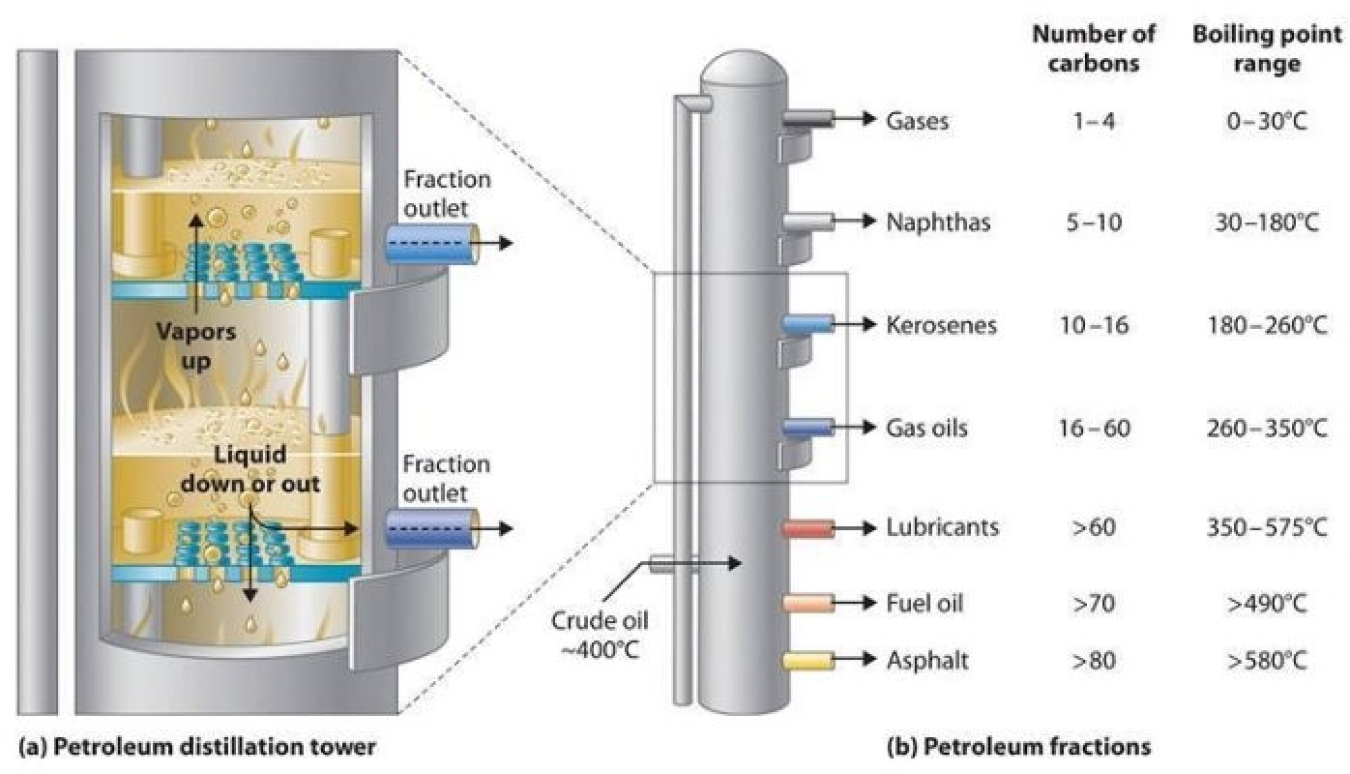New software is being developed which will use algorithms to analyze feeds of different components and determine the optimized configuration.
Industrial Technologies Office
August 11, 2016
Distillation columns like this one are used in a variety of chemical manufacturing applications. Photo courtesy of Organic Chemistry (McMurray).
Designing manufacturing processes can be a lot like solving puzzles: you know the pieces you’re starting with and you know what the end result should be, but it’s your job to determine the best way to accomplish everything that happens in between. Chemical manufacturing processes that utilize distillation present an exciting and interesting challenge because the puzzle pieces can be put together in a number of different ways and still offer a solution.
Distillation is the separation of various components in a chemical mixture based on their unique boiling points – it involves heating a mixture to evaporate off certain components and collecting the vapor and remaining liquid separately. Distillation columns are used throughout the manufacturing sector to separate liquid mixtures into their individual components. When a mixture has multiple components that need to be separated, a series of distillation columns are used, with each individual column designed to separate a specific component from the mixture. “Configuration” refers to the order in which the columns are arranged to separate the components. In the case of distillation, each distillation column is a puzzle piece and the configuration is the completed puzzle.
The more components there are in a mixture, the more different and complex configurations, or solutions to the puzzle, are possible – up to thousands of configurations for a chemical mixture with five different components. As the configurations become more complex, they also become more energy intensive. Consequently, distillation separation processes in the US consume about 2 to 3 Quads of energy per year while accounting for 40 to 70 percent of capital and operating cost for a typical fluid processing plant.
Hundreds of equations are used to model and analyze each possible configuration, and therefore it is difficult and time-consuming for manufacturers to determine the best possible configuration; traditionally system designs have been determined based on the experience and creativity of the process designers and therefore are far from optimal. As a result, industrial distillation systems often consume more energy and are more costly to operate than other possible solutions to the puzzle. Chemical manufacturers needed a systematic and easy-to-use method to model and select the most energy- and cost-efficient configurations for their distillation columns. Not only do they need to determine the optimized configuration from a large number of options, but they also need to make this determination in a relatively short period of time.
New software is being developed by Purdue University in partnership with Dow Chemical Company, Eastman Chemical Company, and ExxonMobil Research and Engineering Company, which will use algorithms to analyze feeds with up to six different components and determine the optimized distillation column configuration. The Department of Energy’s (DOE) Advanced Manufacturing Office (AMO) provided $900,000 for applied research and development of this software, which applies algorithms developed by Purdue researchers under a previous DOE award. It provides chemical manufacturers with the tools they need to determine the way to put the puzzle pieces together to achieve energy-efficient and low-cost designs. Manufacturers will be able to use the software both to design new distillation systems and also to retrofit and reconfigure existing systems. Additionally, the software will be compatible with other software, like process simulators, currently used by the chemical manufacturing industry.
As of June of this year, the research team successfully designed software that can model all 6,128 configurations for a five component mixture in just three and a half hours. The best previous system would require more than 16 hours and would only be able to solve approximately 6,000 out of 6,128 configurations. They also are the first to identify the optimized distillation configuration and generate a list ranking each configuration. Not only can this software determine optimized configurations, but it can also create a search space for all potential configurations, it also provides important information about the total cost of configurations. They have already added new capabilities in process intensification by drawing operable divided-wall column configurations from thermally-linked basic multicomponent configurations. The Purdue researchers have made history by being the first team to solve this problem, which has been plaguing the industry for over fifty years.
The team is now in the final phase of developing a user-friendly, commercial version of the software. Once this innovative software is in the hands of chemical manufacturers, it will provide crucial information necessary to potentially reduce energy consumption by up to 40% and capital and operating costs by 10-40% when compared to conventional configurations. These savings can be achieved across all manufacturing sectors that utilize distillation, including chemical and petrochemical industries, food processing, and biofuels. By increasing energy-efficiency and reducing costs across the chemical manufacturing sector, American manufacturers can stay competitive in the global economy.
To learn more about this project, including the barriers and specific milestones, read our factsheet.

